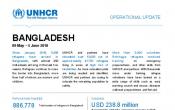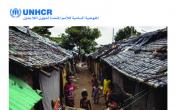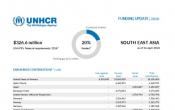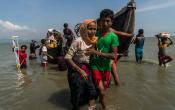Bangladesh
Operation: Bangladesh
Location
{"longitude":90,"latitude":24,"zoom_level":7,"iso_codes":"'BGD'"}
By clicking on the icons on the map, additional information is displayed.
Key Figures
| 2017 year-end results | |
| 250,000 | people of concern have benefitted from the installation of 23 water taps and various wells |
| 47,060 | families received core relief items, some 27,600 families received shelter kits, and 68,300 families received compressed rice husk |
| 3,060 | new latrines and 1,590 bath cubicles constructed during the period providing coverage for 152,900 people |
| 1,100 | UASC and 114 children’s families received targeted support, and 18 child friendly spaces (CFS) were set up |
| 20 | outpatient therapeutic programmes were set up to respond to cases of malnutrition |
| 2017 planning figures | |
| 6,720 | people will be trained in basic hygiene practices |
| 5,000 | new admissions to supplementary feeding programmes |
| 4,800 | people of concern will receive shelter support |
| 3,650 | children aged 3-5 will be enrolled in early childhood education |
| 1,800 | people will be referred to secondary and tertiary medical care |
| 1,000 | people of concern will receive training on how to use computers |
Latest Updates
People of Concern
19%
Increase in
2016
2016
| 2016 | 276,208 |
| 2015 | 231,958 |
| 2014 | 232,485 |

[["Refugees",33207],["Refugee-like situation",243000],["Asylum-seekers",1]]
Loading ...
Bangladesh
< Back
2017
{"categories":[2013,2014,2015,2016,2017,2018],"budget":[13.44780052,12.32102827,15.18430531,13.667946901,67.59621592,220.44281185],"expenditure":[8.35074145,7.54522622,7.57678278,7.28402193,49.60677532,null]}
{"categories":[2013,2014,2015,2016,2017,2018],"p1":[13.35331062,12.30601841,15.17557479,13.60402556,67.58199943,220.44281185],"p2":[0.0944899,0.01500986,0.00873052,0.063921341,0.01421649,null],"p3":[null,null,null,null,null,null],"p4":[null,null,null,null,null,null]}
{"categories":[2013,2014,2015,2016,2017,2018],"p1":[8.2696,7.53473045,7.56913223,7.23156013,49.60571998,null],"p2":[0.08114145,0.01049577,0.00765055,0.0524618,0.00105534,null],"p3":[null,null,null,null,null,null],"p4":[null,null,null,null,null,null]}
Loading ...
CHOOSE A YEAR
- 2014
- 2015
- 2016
- 2017
- 2018
Operational context
The speed and scale of the influx of Rohingya refugees from Myanmar led to the declaration of a UNHCR internal Level 3 emergency in September 2017. The refugee population is highly vulnerable, having fled conflict and experienced severe trauma, and now living in extremely difficult conditions in Bangladesh. In addition, the sudden influx has put a strain on the hosting communities. At the initial stage, UNHCR focused on protection and meeting the emergency standards of service provision to refugees. UNHCR, in close coordination with all actors in the area, contributed at the operational level in the provision of protection, health, nutrition, shelter, site management, WASH and core-relief items. UNHCR enhanced partnerships with different humanitarian actors and stakeholders with a focus on collaboration with local NGOs.The overall response has forged ahead since then and critical protection, shelter, water, sanitation, health, nutrition and other needs have been addressed. Extensive physical, structural, infrastructural and engineering works have been undertaken to organize settlements and establish access and other public service networks. UNHCR has made its largest deployment of its organizational emergency response capacities, and dramatically upped its coordination and operational footprint on the ground.
As the Governments of Bangladesh and Myanmar started to discuss and work out arrangements for the return of the refugees to Myanmar, UNHCR engaged with both to underscore the imperatives of any returns being voluntary, in safety and dignity, sustainable, and with international humanitarian presence and monitoring.
Population trends
Combined with the refugee population present prior to 25 August 2017, over 932,000 refugees are accommodated in various sites and settlements of Cox’s Bazar District. According to the family counting exercise conducted between October and December 2017, some 81 per cent of this population arrived between August and December 2017. Of the total, 55 per cent were under 18 years and 52 per cent were female.Key achievements
- UNHCR established a consolidated, comprehensive identity management system that ensure reliable data at the individual level for management and the delivery of assistance. The unified data facilitates the evidence-based case management at both the individual and collective levels, the out-reach to families to ensures appropriate support and follow-up, and the improvement of protection and delivery of assistance to the refugees.
- Community outreach through construction of seven community centers with integrated information points and 50 trained Community Outreach Members.
- Identification of new settlement areas and development of a macro development plan for Kutupalong settlement in consultation with the Government.
Unmet needs
- The process of the Government registration for international NGOs remained lengthy and complicated, which slowed down the operational capacity in the overall response.
- Due to the magnitude of the influx, refugees arrived at new sites before adequate infrastructure and services could be established, resulting in the service delivery only at emergency standards.
- In Ukhia and Teknaf sub-districts, the refugee influx has had a significant impact on host communities, including market access, labour competition, deforestation, and inflation. More support is required to address the needs of host communities for their sustainable socio-economic development, which would also have an impact on the life of refugees.
Working environment
UNHCR will continue its protection interventions for a small number of urban refugees and some 33,000 registered refugees from Myanmar living in the camps in Bangladesh. The host country has provided the required land for official camps, issued birth certificates to all new-born babies in them, and maintains law and order in camps.Based on the outcome of the census conducted by the Government of Bangladesh in 2016 for the estimated 200,000 - 500,000 people of concern from Myanmar’s northern Rakhine Sate, UNHCR will work closely with the Government to promote a community-based protection framework for them.
Key priorities
In 2017, the UNHCR operation in Bangladesh will focus on:• improving access to justice through the provision of legal assistance, strengthening prevention and responses to sexual and gender-based violence;
• improving the environment for child protection;
• ensuring timely update of the registration database as well as issuance of birth certificates;
• advocating a move away from the parallel systems established inside camps with a particular emphasis on access to formal education and the Government’s health care facilities.






